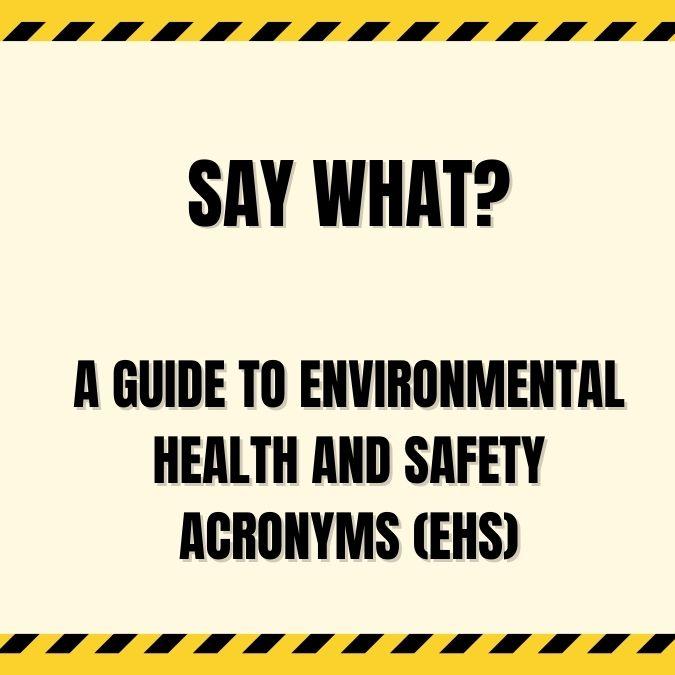In the world of Environmental Health and Safety (EHS), there are a lot of acronyms thrown around. It can be difficult to keep up with them all, and even harder to know what they mean. This guide is designed to help you understand some of the most important EHS acronyms, so you can communicate more effectively and stay safe on the job.
- OSHA – Occupational Safety and Health Administration: OSHA is a federal agency that enforces safety and health regulations in the workplace. It sets and enforces standards for workplace safety and health, and provides training and education to employers and employees on safety and health topics.
- PPE – Personal Protective Equipment: PPE refers to any equipment worn to minimize exposure to a variety of hazards. This includes items such as hard hats, goggles, respirators, earplugs, and many others.
- HAZWOPER – Hazardous Waste Operations and Emergency Response: HAZWOPER refers to OSHA regulations that apply to employers and employees who work with hazardous substances, including hazardous waste and emergency response operations.
- HSE – Health and Safety Executive: The Health and Safety Executive (HSE) is an independent regulator for workplace health and safety in Great Britain.
- GHS – Globally Harmonized System of Classification and Labelling of Chemicals: GHS is an internationally agreed system for the classification and labeling of chemicals, which is designed to ensure that chemical hazards are clearly communicated to workers and consumers.
- MSDS – Material Safety Data Sheet: MSDS is a document that provides information on the properties, hazards, and safe handling of a chemical substance.
- SDS – Safety Data Sheet: SDS is a document that provides information on the properties, hazards, and safe handling of a chemical substance. It is similar to a MSDS.
- COSHH – Control of Substances Hazardous to Health: COSHH is a UK regulation that requires employers to control exposure to hazardous substances in the workplace.
- EHS – Environmental Health and Safety: EHS refers to the management of environmental and safety risks in the workplace. It involves identifying, evaluating, and controlling hazards to protect workers, the environment, and the community.
- EHSMS – Environmental Health and Safety Management System: EHSMS is a systematic approach to managing environmental and safety risks in the workplace. It includes policies, procedures, and processes to identify, evaluate, and control hazards.
- RAC – Risk Assessment Code: RAC is a code used to classify the level of risk associated with a particular hazard or activity.
- HACCP – Hazard Analysis and Critical Control Points: HACCP is a systematic approach to identifying and controlling hazards in the food industry to ensure food safety.
- NEPA – National Environmental Policy Act: NEPA is a federal law that requires federal agencies to consider the environmental impacts of their actions and to make decisions that will protect the environment.
- RCRA – Resource Conservation and Recovery Act: RCRA is a federal law that regulates the management of hazardous waste in the United States.
- TSCA – Toxic Substances Control Act: TSCA is a federal law that regulates the manufacture, use, and disposal of chemicals in the United States.
- EPCRA – Emergency Planning and Community Right-to-Know Act: EPCRA is a federal law that requires facilities to report the release of certain chemicals to the government and the public.
- SPCC – Spill Prevention, Control, and Countermeasure: SPCC is a federal regulation that requires certain facilities to develop and implement plans to prevent oil spills and to respond to spills that do occur.
- BBS – Behavior-Based Safety: BBS is a process that focuses on changing workers’ behavior to reduce accidents and injuries.
- JSA – Job Safety Analysis: JSA is a process used to identify and evaluate the hazards associated with a specific job or task.
- LOTO – Lock Out Tag Out: LOTO is a procedure used to prevent the accidental start-up of machinery or equipment during maintenance or repair.
- PEL – Permissible Exposure Limit: PEL is a regulatory limit for the amount of a substance that a worker can be exposed to over a specific period of time without experiencing adverse effects.
- STEL – Short-Term Exposure Limit: STEL is a regulatory limit for the amount of a substance that a worker can be exposed to over a short period of time without experiencing adverse effects.
- TWA – Time-Weighted Average: TWA is a measure of the average exposure to a substance over a specific period of time.
- TLV – Threshold Limit Value: TLV is a recommended limit for the amount of a substance that a worker can be exposed to without experiencing adverse effects.
- IDLH – Immediately Dangerous to Life or Health: IDLH is a term used to describe an atmosphere that poses an immediate threat to life or health. This can include an atmosphere that is toxic, flammable, or explosive.
- NFPA – National Fire Protection Association: NFPA is a non-profit organization that develops and publishes standards and codes for fire protection and safety.
- ASTM – American Society for Testing and Materials: ASTM is a non-profit organization that develops and publishes standards for materials, products, systems, and services.
- ANSI – American National Standards Institute: ANSI is a non-profit organization that coordinates the development and use of voluntary consensus standards in the United States.
- ISO – International Organization for Standardization: ISO is an international organization that develops and publishes standards for a wide range of products, services, and systems.
- CE – Conformité Européene (European Conformity): CE is a marking that indicates that a product meets the safety, health, and environmental protection requirements of the European Union.
By familiarizing yourself with these EHS acronyms, you’ll be better prepared to communicate effectively and stay safe on the job. Remember, safety is everyone’s responsibility and understanding the terms used in the industry will help you stay aware of the hazards and take the necessary precautions to keep yourself and others safe.










